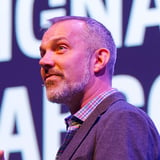Summary
On the final day of the conference, the focus shifted from product and processes to people, emphasizing the practice of human-centered design internally within teams as well as externally for customers. Peter Marrahold opened the session, stressing the importance of maintaining humanism at scale in design work. Milestone followed with a case study on empathetic transformation across multiple disciplines, showing how to overcome political challenges in organizational change. My Bill presented practical strategies for building design-minded communities within legacy companies by integrating diverse disciplines. Two emotionally impactful talks highlighted the necessity of self-care post-pandemic, urging professionals to prioritize their own well-being before helping others. Word Caps expanded on professional self-care approaches, while Meun explored career transitions from managerial roles to principal individual contributor positions, encouraging people to stay authentic to their passions. The finale from Willer focused on opportunities for designers to create government services that prioritize equity and resilience, underscoring the responsibility designers hold when shaping systems for millions. The day provided a balance of practical advice and heartfelt reminders, aiming to resonate both mentally and emotionally with the audience.
Key Insights
-
•
Human-centered design should be applied within teams, not just for customers.
-
•
Scaling design requires maintaining a focus on humanism at every level.
-
•
Empathy across disciplines is key to successful organizational transformation.
-
•
Building design communities in century-old companies requires intentional inclusion of various disciplines.
-
•
Self-care is essential for sustainable professional practice, especially post-pandemic.
-
•
Career growth can be vertical or lateral, and it’s important to stay true to personal passions.
-
•
Transitioning from managerial to principal individual contributor roles offers a path for experienced professionals.
-
•
Designers have a responsibility to create equitable, resilient government services.
-
•
Addressing politics and reservations openly aids in transformation and community-building efforts.
-
•
Putting on your own oxygen mask first is a metaphor for prioritizing one’s own well-being before assisting others.
Notable Quotes
"We often talk about our customers, but we forget the other people involved: ourselves and our teams."
"Design at scale is really humanism at scale."
"Transformation happens through empathy across multiple disciplines and reporting lines."
"Building design communities in legacy companies means bringing other disciplines into the fold."
"Taking care of ourselves first is essential before we can effectively care for others."
"Growth in your career doesn’t always have to be vertical; sometimes sideways or diagonal moves help you stay true to yourself."
"Transitioning to a principal role lets you focus on what you love without managing teams directly."
"Designers must take responsibility when designing systems that impact millions."
"Overcoming reservations and politics is part of enabling transformation."
"Putting on your oxygen mask first is a metaphor for self-care we often neglect in professional life."
Or choose a question:
















More Videos

"Research ops was actually there before research at TravelPerk, supporting designers first."
Ned Dwyer Emily Stewart James WallisThe Intersection of Design and ResearchOps
September 24, 2024

"Most of our designers are contractors; they have limited voice because they’re bound by contracts."
Michael LandEstablishing Design Operations in Government
February 18, 2021

"It took competitors over seven years to catch up to where Apple is with voice dictation and accessibility."
Sam ProulxTo Boldly Go: The New Frontiers of Accessibility
November 18, 2022

"With seven UXters for 400 products, the math doesn’t add up, so we must choose where we focus."
Vasileios XanthopoulosA Top-Down and Bottom-Up Approach to User-Centric Maturity at Scale
January 8, 2024

"Younger visitors are nearly twice as likely to engage with digital chat or help but are less satisfied afterward."
Andrew Custage Michael MallettThe Digital Journey: Research on Consumer Frustration and Loyalty
March 29, 2023

"It was taking an average of 14 days from intake to delivery for most of our research projects."
Marjorie Stainback Kelsey KingmanTransforming Strategic Research Capacity through Democratization
October 24, 2019

"Connection is the energy that exists between people when they feel seen, heard, and valued."
Alla WeinbergCross-Functional Relationship Design
December 6, 2022

"Change is the only constant, so designing insight sharing with self-directed learning is critical."
Jerome “Axle” BrownHow to Use Self-Directed Learning to Ensure Your Research Insights are Heard and Acted Upon
March 11, 2021

"Embrace diversity and create belonging means everyone feels they truly belong, not just fit in."
Jen Crim Jess Quittner Saritha Kattekola Alex Karr Gurbani PahwaCulture, DIBS & Recruiting
June 11, 2021
















